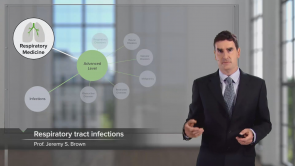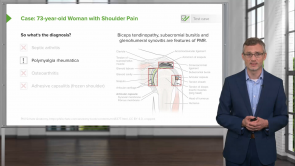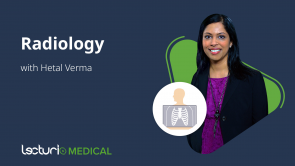Basics of Radiology and Computed Tomography (CT)
Über den Vortrag
Der Vortrag „Basics of Radiology and Computed Tomography (CT)“ von Hetal Verma, MD ist Bestandteil des Kurses „Year 3 – Internal Medicine“. Der Vortrag ist dabei in folgende Kapitel unterteilt:
- History and Basics of Radiology
- Computed Tomography
Quiz zum Vortrag
Which among the following is NOT one of the four basic radiological densities?
- Muscle
- Fat
- Air
- Calcium
- Fluid
Summation of shadows is seen…?
- …when images are created by multiple overlapping tissue densities.
- …when edges of an object are seen in the interface with a different density.
- …when there is a loss of normal borders between thoracic structures.
- …as a crescentic and radiolucent finding due to lung cavity that is filled with air and has a round radiopaque mass.
- …due to bronchial wall thickening.
Which of the following statements regarding orthogonal imaging is FALSE?
- It evaluates a 2-dimensional structure with 3 projections.
- It evaluates a 3-dimensional structure with 2-dimensional images in two different views.
- It helps to identify the exact location of an object in the body.
- Common views include anteroposterior and lateral.
- Imaging with 2 projections is performed whenever possible.
A 60-year-old female is brought to the emergency clinic with complaints of shortness of breath, pedal edema, persistent cough with wheeze, and fatigue. She has a long history of hypertension. Which diagnostic test must be normal before administration of contrast CT scan?
- Renal function tests
- Liver function tests
- Baseline EKG
- Chest X-ray
- Spirometry
All the following sentences regarding CT scans are true EXCEPT…?
- They use lesser levels of ionizing radiation than radiographs.
- A CT image is a matrix of thousands of different pixels.
- Hounsfield units are based on how much x-ray beam is absorbed by the object.
- Hounsfield units are a measure of pixels and reflect the density of an object.
- Air has the least Hounsfield units of -1000 HU.
Which of the following is the CORRECT match?
- Sagittal: looking at the patient from the side.
- Coronal: looking at the patient from the side.
- Axial: looking at the patient from the front.
- Sagittal: looking at the patient from the feet up to the head.
- Axial: looking at the patient from the side.
A 52-year-old man is scheduled for a CT scan abdomen with oral contrast. Which of the following is FALSE regarding CT with oral contrast?
- The contrast must be given about 15-30 minutes prior to the exam.
- Oral CT contrast helps in distending and defining the bowel.
- Dilute barium sulfate is the most commonly used agent.
- 1000-1500 ml of the contrast is given to the patient orally.
- The patient should be asked if he is allergic to contrast.
Kundenrezensionen
4,3 von 5 Sternen
| 5 Sterne |
|
2 |
| 4 Sterne |
|
1 |
| 3 Sterne |
|
1 |
| 2 Sterne |
|
0 |
| 1 Stern |
|
0 |
Nice lecture very complete and in very litlle time. keep up with the good job
Good for beginners... Explanation from scratch.. Easy language... Explanation with imagery examples is a highlight
Very clear and objective explanation. I wouldn't mind if there were a few more details. :)
Overal good resource. But i think it could be a little bit more detailed to be really usefull for medical school.






